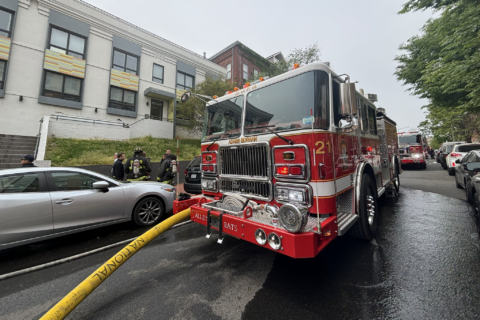D.C. officials say they are making immediate changes to how they clear homeless encampments after a resident of a camp in Northeast D.C. was taken to the hospital on Monday after being inadvertently picked up by a Bobcat front-end loader.
The incident Monday happened while the encampment was being cleared out from underneath a rail bridge on L Street in D.C.’s NoMa neighborhood.
Wayne Turnage, D.C.’s deputy mayor for health and human services, said his team had checked the tent before the Bobcat moved in to clear it. What remains unclear, he said, is if the man reentered the tent or if he was somehow missed when the tent was checked.
“Whatever the case, we will make sure that it does not happen again,” Turnage told WTOP.
Immediate changes have been made, Turnage said, when it comes to how the machines are used during the clearing of an encampment.
“There will be a check to make sure there is absolutely nobody in that tent, and then a person will stand there while the Bobcat comes to make sure nobody comes in the tent after the check is made,” Turnage said.
Turnage said he was told the man was taken to the hospital to be evaluated but will be OK.
During the incident Monday, equipment was being used to push tents and their contents over a 3-foot-tall metal rail that separated the road from the sidewalk where the tents were set up. As the loader went into the tent, the man could be heard screaming. City workers, police and advocates for the homeless ran to the scene.
The incident led to some tense moments as advocates for the homeless tried to get to the man and police tried to keep the crowds away. Some people could be seen trying to get past police. One woman who was on the ground was dragged out by officers, and the area was cordoned off.
“Across the street, we heard the man yelling, but they didn’t hear him when they were right next to them so we jumped over the things on the sidewalk to get to him,” said Yonce X, who was with one of the groups helping the homeless people at the camp.
Police — and at one point, a member of an advocacy group — attended to the man. And about 20 minutes later, he was taken to the hospital in an ambulance.
Jamal Weldon — who was at the site for the deputy mayor’s office — said an ambulance was called immediately, but it took 15 to 20 minutes to arrive.
D.C. Council member Charles Allen called the incident “incredibly frustrating.”
While he wants to see energy used to get people out of tents on the streets and into stable housing, Allen said he cannot lose sight of the humanity of the people who live in the encampments in the process.
“This is the mayor’s pilot program to help move people in,” Allen said, “and while it holds some potential, we’ve got to have accountability for every step of the process.”
Allen said he would like to see workers check each tent and only use the machines at the end with large items and biohazards.
“I don’t know why we need heavy machinery to be picking up a tent that might even have somebody inside of it,” Allen said.
When asked about why the machines are used, Turnage said it is for the safety of those removing the tents.
“A lot of stuff is accumulated; they can be fairly heavy,” he said.
Concerns for the health of those who live in the encampments — especially during the pandemic — are driving the effort to move people out of camps and into housing, the deputy mayor said. He added there is a public safety element to it as well, because some people prey on those living in the camps.
However, in a Twitter thread, Ward 1 Council member Brianne Nadeau said the incident has causes her to have additional concerns about the effort of moving people into housing. The process lacks compassion and causing “a lot of trauma,” Nadeau said, adding that “there is no room for mistakes.”
One of the reasons that we do not disassemble encampments is because there are risks involved. There are risks involved in asking people to move all of their belongings and risks involved in forcibly removing people from their home.
— Brianne K. Nadeau (@BrianneKNadeau) October 4, 2021
One of the residents of the camp who didn’t want to be identified said he’s lived there for two years, but with the help of the city now has a lease for a place to live. He is OK with the encampments being removed, he said, as long as those who live in them are offered housing.
Edward Spriggs, who lives in the community, also agreed that the tent camps should be cleaned up, but said as of Monday afternoon, he does not have a place to go. The city is working with him to find a new home.
“Having somewhere to live, that seems to have become the rock and the hard spot right now,” he said.
There are a lot of people on edge in the camp because they were promised housing but so far have no place to go, said Jonny Dailey of the group HIPS, which is helping those in the camp.
Spriggs is to set up another tent for him and his dog nearby, until he finds out if he has housing available to him.
“A lot of folks, they’re not leaving. They didn’t get the housing, so they are not going to leave,” Dailey said.
D.C. identified 43 long-term residents in the camp, Turnage said, and they will be provided housing — though it’s unclear how many actually have been placed into homes.
Turnage said the city is also looking to find homes for some newer residents who have appeared since the plan to remove the encampment was announced.
D.C. also has an apartment lined up for the man who was lifted by the Bobcat tractor, Turnage said.
As for the camp, the deputy mayor said the process of removing the encampment will resume on Tuesday.
Later Monday at another homeless encampment in Northwest D.C., firefighters responded to a tent fire and found a person dead inside. The person’s identity has not yet been released.








